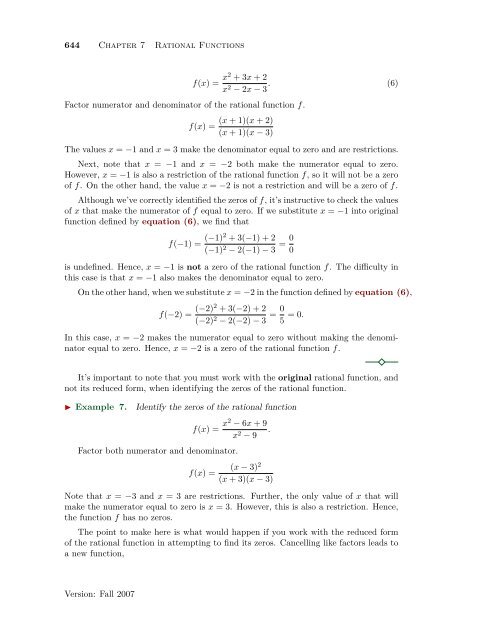Chapter 7 Rational Functions - College of the Redwoods
Chapter 7 Rational Functions - College of the Redwoods
Chapter 7 Rational Functions - College of the Redwoods
You also want an ePaper? Increase the reach of your titles
YUMPU automatically turns print PDFs into web optimized ePapers that Google loves.
644 <strong>Chapter</strong> 7 <strong>Rational</strong> <strong>Functions</strong><br />
f(x) = x2 + 3x + 2<br />
x 2 − 2x − 3 . (6)<br />
Factor numerator and denominator <strong>of</strong> <strong>the</strong> rational function f.<br />
f(x) =<br />
(x + 1)(x + 2)<br />
(x + 1)(x − 3)<br />
The values x = −1 and x = 3 make <strong>the</strong> denominator equal to zero and are restrictions.<br />
Next, note that x = −1 and x = −2 both make <strong>the</strong> numerator equal to zero.<br />
However, x = −1 is also a restriction <strong>of</strong> <strong>the</strong> rational function f, so it will not be a zero<br />
<strong>of</strong> f. On <strong>the</strong> o<strong>the</strong>r hand, <strong>the</strong> value x = −2 is not a restriction and will be a zero <strong>of</strong> f.<br />
Although we’ve correctly identified <strong>the</strong> zeros <strong>of</strong> f, it’s instructive to check <strong>the</strong> values<br />
<strong>of</strong> x that make <strong>the</strong> numerator <strong>of</strong> f equal to zero. If we substitute x = −1 into original<br />
function defined by equation (6), we find that<br />
f(−1) = (−1)2 + 3(−1) + 2<br />
(−1) 2 − 2(−1) − 3 = 0 0<br />
is undefined. Hence, x = −1 is not a zero <strong>of</strong> <strong>the</strong> rational function f. The difficulty in<br />
this case is that x = −1 also makes <strong>the</strong> denominator equal to zero.<br />
On <strong>the</strong> o<strong>the</strong>r hand, when we substitute x = −2 in <strong>the</strong> function defined by equation (6),<br />
f(−2) = (−2)2 + 3(−2) + 2<br />
(−2) 2 − 2(−2) − 3 = 0 5 = 0.<br />
In this case, x = −2 makes <strong>the</strong> numerator equal to zero without making <strong>the</strong> denominator<br />
equal to zero. Hence, x = −2 is a zero <strong>of</strong> <strong>the</strong> rational function f.<br />
It’s important to note that you must work with <strong>the</strong> original rational function, and<br />
not its reduced form, when identifying <strong>the</strong> zeros <strong>of</strong> <strong>the</strong> rational function.<br />
◮ Example 7.<br />
Identify <strong>the</strong> zeros <strong>of</strong> <strong>the</strong> rational function<br />
f(x) = x2 − 6x + 9<br />
x 2 .<br />
− 9<br />
Factor both numerator and denominator.<br />
f(x) =<br />
(x − 3) 2<br />
(x + 3)(x − 3)<br />
Note that x = −3 and x = 3 are restrictions. Fur<strong>the</strong>r, <strong>the</strong> only value <strong>of</strong> x that will<br />
make <strong>the</strong> numerator equal to zero is x = 3. However, this is also a restriction. Hence,<br />
<strong>the</strong> function f has no zeros.<br />
The point to make here is what would happen if you work with <strong>the</strong> reduced form<br />
<strong>of</strong> <strong>the</strong> rational function in attempting to find its zeros. Cancelling like factors leads to<br />
a new function,<br />
Version: Fall 2007

















